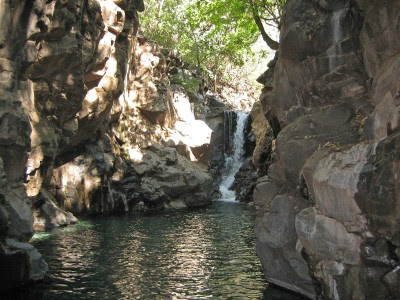This is the story of seven hikers whose driving passion was to climb the 14,200 foot Nevado de Colima volcano on the border of Jalisco and Colima states in Mexico. There is a volcanology observatory at the 13.000 foot level. My friend Norm Tihor and I had already been escorted off the mountain by the observatory guard and three volcanologists. At that time the army was stationed at the entrance road to the observatory near 12,000 feet just to insure that nobody would be exposed to the frequent eruptions of poisonous gas and ash and potential lava bombs from the active Volcan de Fuego (fire) on the south flank of Nevado. So on this return trip we had arranged to climb up the steep NE backside of the extinct volcano, on the opposite side from the observatory and avoid any contact with the authorities.

On our arrival near our makeshift camp at 11,000 feet, we were all super excited and smiling bravely at our first sight of our objective. From here it looked like the Materhorn. There were four trained rock climbers and four experienced mountain hikers in our group from Ajijic and Guadalajara. From previous experience we knew that it was important to acclimatize ourselves overnight to high elevation. So we happily set up camp and then went on a day hike in the direction of the observatory, leaving our King of the Camp to make dinner.

To our surprise, the normally locked gate on the road to the observatory was open. At this elevation, it was an exhausting trudge, just moving one foot in front of the other. But the reward was well worth the effort when we got our first view of Fuego and the observatory. The buildings were all reinforced concrete, roofs included, with guy wires holding them down to the crater rim. Like a science fiction scene, it was obvious that serious danger could be expected if Fuego blew.

Back in camp, Christopher English had a fire going and foil-wrapped steaks with onions and green peppers ready for baking in hot coals. Were we ever the fortunate ones. Sitting around later with hot chocolate and Baileys and full stomachs we thought about the challenges to face us the next day.

The next morning we were a little chilly but it was an incredible day with amazing clarity. It's usual for Nevado to be capped with clouds by late morning but the conditions were exceptional. Once on the trail, it was shirt sleeve weather even at 14,000 feet. What unbelievable luck!

We quickly left the dirt camp road and headed up towards the beginning of the rock outcrops. The going was easy and soon we arrived at the exposed rock base and our first view across the crater to the observatory. We all took a major rest here because the next part would be up loose volcanic ash.

It was steep and exhausting as it seemed that for every two steps ahead we slipped back one. We learned to step directly on the tuffs of grass to help with our footing and to bring baskets for our hiking poles next time.

As we got out of the ash and onto the solid rock wall, the scenery became awesome. The rock formations caused us to feel like we were in the throat of a volcano. It was very exciting to cautiously follow narrow ledges with sheer drops.

The valley was practically 10,000 feet below us. What an exhilerating feeling. We felt alive!
 Double click to enlarge
Double click to enlargeFinally we arrived on the actual narrow ridge of the crater. There are two stunning high points. We had come along the wall of the lower northern one and now crossed over the bridge between them. In the photo two of us are just starting across, while Norm is reaching up to grasp the top of the high peak.
 Double click to enlarge
Double click to enlargeBelow, Larry Laframboise and Christopher are in the final push. It was surreal to be in such an environment. Words really can't describe it. We felt on top of the world!

And there right in front of us as the view opened to the south, was the Volcan de Fuego. What a incredible sight we thought as we looked down on it.

And then it blew!! No fixed photograph can give the sense of a roiling, billowing, actively spewing plume of gases and ashes reaching thousands of feet high in seconds. Our emotions were truly overwhelmed. Then we realized that the gas and ash cloud was coming right at us. Suddenly we thought, "where was that cave we had passed just below us?" Then we noticed that it was going to go right by us, not engulf us. Panic became excitement again.

We were then able to pose in a relaxed manner for our group summit shot. Larry, Gerry, Duncan Poole, Norm, Robert Knapp our climbing guide, Christopher and Rosario Toledo, one enthusiastic lady. We had done it! 14,200 feet. A real adventure.
 Double click to enlarge
Double click to enlargeDown we went, so much easier than ascending. The most difficult part of a climb is often called the crux. This one is called the Jota due to the rock formation being in the shape of a J.

And then the fun began. We had spent time and effort to climb the ash slope. Now we shot the scree, I mean ash. It requires a skating technique as the ash slides underfoot like marbles. Ten minutes to go down what took an hour to ascend. What a thrill!

Each of us stirred up a storm of dust and had a ball. Then back through the trees and down to our camp. After a short rest, we packed up camp and headed for a victory celebration at a local restaurant. This trip had been such a success and an experience beyond our imagination that we hope to do it annually.




























